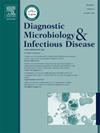Evaluation of five colorimetric methods for rapid detection of multidrug-resistant Mycobacterium tuberculosis isolates
IF 2.1
4区 医学
Q3 INFECTIOUS DISEASES
Diagnostic microbiology and infectious disease
Pub Date : 2025-05-15
DOI:10.1016/j.diagmicrobio.2025.116903
引用次数: 0
Abstract
Aims
Tuberculosis (TB) continues to pose a major threat to global public health, particularly due to the increasing prevalence of antimicrobial resistance. This study aimed to evaluate the performance of five different colorimetric drug susceptibility testing (DST) methods, including a newly developed assay.
Methods
A total of 56 clinical Mycobacterium tuberculosis strains with varying resistance profiles, along with two ATCC reference strains, were tested against four first-line anti-TB antibiotics: isoniazid (INH), rifampicin (RIF), streptomycin (STR), and ethambutol (EMB). The assays NRTA, CRTA, CVDTA, MGDTA, and a newly developed disk-based resazurin tube assay (DBRTA) were performed in Middlebrook 7H9 broth at standard critical drug concentrations. Results were compared against the BACTEC MGIT 960 system as the reference method.
Results
The DST results were obtained within 7 to 14 days. The overall agreement with the reference method was 96.87 % for NRTA, 95.08 % for CRTA, 93.75 % for both CVDTA and MGDTA, and 95.53 % for DBRTA.
Conclusions
Colorimetric assays, especially DBRTA, offer cost-effective, rapid, and scalable solutions for MDR-TB detection. Their simplicity and affordability make them particularly suitable for routine use in resource-limited settings, contributing to improved TB management and global control efforts.
五种快速检测耐多药结核分枝杆菌分离株的比色法评价
结核病(TB)继续对全球公共卫生构成重大威胁,特别是由于抗菌素耐药性日益普遍。本研究旨在评价五种不同的比色药敏试验(DST)方法的性能,包括一种新开发的测定方法。方法对56株不同耐药谱的结核分枝杆菌临床菌株及2株ATCC对照菌株进行异烟肼(INH)、利福平(RIF)、链霉素(STR)、乙胺丁醇(EMB) 4种一线抗结核药物的耐药性检测。NRTA, CRTA, CVDTA, MGDTA和新开发的圆盘式reazurin管法(DBRTA)在Middlebrook 7H9肉汤中以标准临界药物浓度进行测定。结果与BACTEC MGIT 960系统作为参考方法进行了比较。结果DST结果在7 ~ 14天内得到。与参考方法的总体一致性NRTA为96.87%,CRTA为95.08%,CVDTA和MGDTA均为93.75%,DBRTA为95.53%。结论比色法,特别是DBRTA,为耐多药结核病检测提供了经济、快速和可扩展的解决方案。它们的简单性和可负担性使它们特别适合在资源有限的环境中常规使用,有助于改善结核病管理和全球控制工作。
本文章由计算机程序翻译,如有差异,请以英文原文为准。
求助全文
约1分钟内获得全文
求助全文
来源期刊
CiteScore
5.30
自引率
3.40%
发文量
149
审稿时长
56 days
期刊介绍:
Diagnostic Microbiology and Infectious Disease keeps you informed of the latest developments in clinical microbiology and the diagnosis and treatment of infectious diseases. Packed with rigorously peer-reviewed articles and studies in bacteriology, immunology, immunoserology, infectious diseases, mycology, parasitology, and virology, the journal examines new procedures, unusual cases, controversial issues, and important new literature. Diagnostic Microbiology and Infectious Disease distinguished independent editorial board, consisting of experts from many medical specialties, ensures you extensive and authoritative coverage.

 求助内容:
求助内容: 应助结果提醒方式:
应助结果提醒方式:


